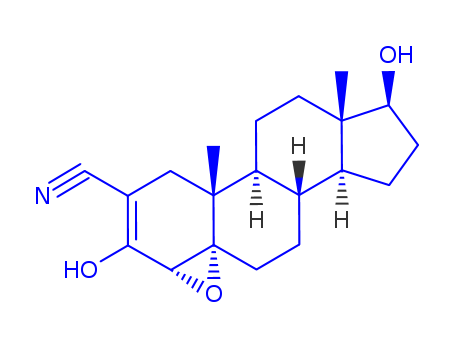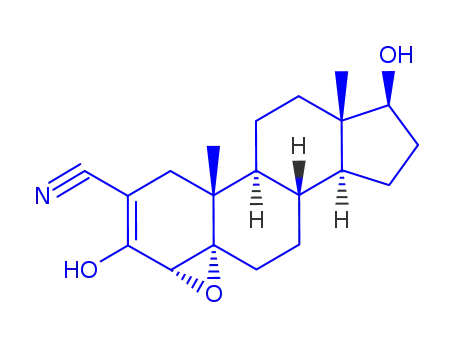Your Location:Home > Products > Veterinary APls > Trilostane



CasNo: 13647-35-3
MF: C20H27NO3
Appearance: tan crystals
| Description | Trilostane is an active pharmaceutical ingredient (API) that is used to treat endocrine disorders, such as Cushing's syndrome, Conn's syndrome, and postmenopausal breast cancer |
|
treatment of Cushing's syndrome |
Trilostane is an inhibitor of 3β-hydroxysteroid dehydrogenase used in the treatment of Cushing's syndrome and primary hyperaldosteronism. These are both disorders where excess amounts of corticosteroid hormones are produced in the body. Corticosteroids are essential for the body to make use of carbohydrates, fats and proteins and for a normal response to stress. They are also necessary for the regulation of salt and water balance in the body. Trilostane helps prevent the production of corticosteroids, controlling the symptoms associated with these disorders. Trilostane can also be useful in the treatment of breast cancer that has relapsed in women who have gone through menopause. |
|
Uses in dogs |
Trilostane was withdrawn from the United States market in April 1994. However, it was approved in 2008 for the treatment of Cushing's disease (hyperandrenocorticism) in dogs. It is also the first drug approved to treat both pituitary-and adrenal-dependent Cushing's in dogs. 1. has kidney or liver disease. 2. takes certain medications used to treat heart disease. 3. pregnant. 4. taking other medicines, including those available to buy without a prescription, herbal or complementary medicines. 5. had an allergic reaction to this or any other medicine. |
|
Indications |
Trilostane can inhibit 3β-dehydrogenase in the synthesis of corticosteroids, and decrease the synthesis of cortisol and aldosterone. It also can be used in the treatment of Cushing's syndrome (hypercortisolism) and primary aldosteronism. But the efficacy to treat Cushing's syndrome (hypercortisolism) is not as metyrapone. This product also has a significant role in lowering blood testosterone levels, which may be related with that its synthesis is inhibited. |
|
The treatment of advanced breast cancer |
Breast cancer is the most common type of tumor in women. Currently, for postmenopausal patients with hormone receptor-positive or unknown, clinical treatments unanimously recommend to be the preferred antiestrogen therapy, and the role of this therapy in delaying disease progression and improving survival time also has been affirmed and confirmed in numerous studies of breast cancer. Trilostane (trade name Modrenal) developed by the biotechnology company has already been on the market. It can be used for the treatment of postmenopausal women that hormone-selective cancer has spread outside the breast. The pharmaceutical uses two ways to slow down the disease progression. For hormone-sensitive breast cancer, estrogen promotes the growth of cancer cells by acting to the two receptors. Estrogen receptor α is cancer accelerator, and estrogen receptor β is the brake. Modrenal strengthens estrogen adsorption to the estrogen receptor β, and weakens the adsorption to estrogen receptor α. Meanwhile it also acts on another loci AP1in cell DNA to reduce cell proliferation. |
|
Manufacturing Process |
(A)17β-acetoxy-4α,5α-epoxyandrostano[2,3-d]isoxazole, melting point 228.6°C to 229.8°C (corrected) recrystallized from a benzene-methanol mixture, [α]D25 = +76.5°C (1% in chloroform), was prepared by treating 17β- acetoxy-4-androsteno[2,3-d] isoxazole with maleic anhydride and hydrogen peroxide in methylene dichloride solution. (B)2α-cyano-4α,5α-epoxandrostan-17β-ol-3-one was prepared by treating 17β-acetoxy-4α,5α-epoxyandrostano[2,3-d] isoxazole with sodium methoxide, and was obtained in the form of tan crystals, melting point 257.8°C to 270.0°C (decomposition) (corrected) when recrystallized from a pyridine_x0002_dioxane mixture. |
|
Brand name |
Modrastane (Bioenvision). |
|
Therapeutic Function |
Corticosteroid antagonist |
|
General Description |
Trilostane inhibits the production of adrenal steroids, such as cortisol and aldosterone. It is used to treat aldosteronism. |
|
Biochem/physiol Actions |
Trilostane is an inhibitor of 3 β-hydroxysteroid dehydrogenase (3-β-HSD or delta 5-delta 4-isomerase), an essential enzyme for the biosynthesis of all classes of hormonal steroids. It has been used in the treatment of Cushing′s syndrome for stopping the production of cortisol, and is currently approved for dogs in the US, but is still a human drug in the UK and other countries. It is being investigated as a possible treatment for both breast cancer and prostate cancer to prevent the synthesis of estrogens and androgens from endogenous precursors. It has also been used to inhibit endogenous production of progesterone in research studies. |
|
Factory |
Liaoning Pharmaceutical Innovation Co.,Ltd. was registered on September 16, 2021, with a registered capital of 12 million. It is located in Panjin Fine Chemical Industrial Park, Liaoning. It is an enterprise integrating the development, research and production of raw materials and intermediate processes. |
InChI:InChI=1/C20H27NO3/c1-18-7-6-14-12(13(18)3-4-15(18)22)5-8-20-17(24-20)16(23)11(10-21)9-19(14,20)2/h12-15,17,22-23H,3-9H2,1-2H3/t12-,13-,14-,15-,17+,18-,19+,20+/m0/s1
The present invention relates to a metho...
![4α,5-epoxy-(5α)-androstano[2,3-<i>d</i>]isoxazol-17β-ol](/upload/2024/11/7a0a30b3-e5fb-4250-93c3-902ab704f427.png)
4α,5-epoxy-(5α)-androstano[2,3-d]isoxazol-17β-ol


Trilostane
| Conditions | Yield |
|---|---|
|
4α,5-epoxy-(5α)-androstano[2,3-d]isoxazol-17β-ol; With sodium hydroxide; In methanol; at 40 - 45 ℃; for 2h;
With acetic acid; In methanol; water; at 40 - 45 ℃; for 2h;
|
95% |

4α,5-epoxy-(5α)-androstano[2,3-d]isoxazol-17β-ol